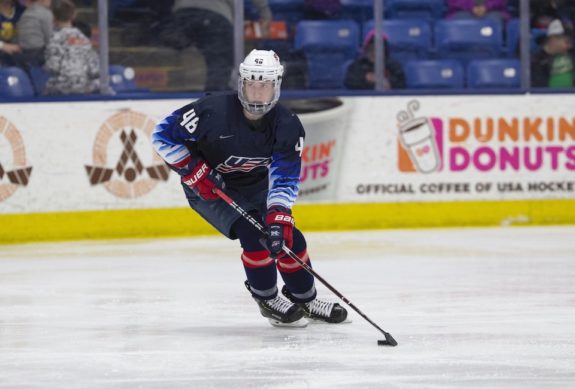Amidst another somewhat disappointing season that was meant to be the end of the rebuild, the Ottawa Senators have made a big move, post-trade deadline. They signed former fifth overall pick in 2020, Jake Sanderson, to a three-year, entry-level deal.
Now, before you get too excited, the son of former NHLer Geoff Sanderson isn’t expected to join the everyday lineup immediately. But let’s explore what brought him to the precipice of becoming the best defenseman to join the team since Thomas Chabot.
Sanderson’s Pre-Draft Scouting Report
Sanderson didn’t exactly light it up in his draft year. He was thought of as a mobile, smart defenseman with slightly above average offensive instincts. He put up nine goals and 43 points in 66 games with the Under-18 United States National Team Development Program (USNTDP) and the USNTDP Juniors. Although he’s a two-way defenseman, and those numbers seem solid, which they are, he didn’t exactly blow scouts out of the water and project as a superstar defenseman.
But the Senators saw something in him, which is why they selected the 6-foot-2, 190-pound defenseman a few spots before his pre-draft projection. Part of the reason why, is that by all accounts, he had a stellar second half of the season. He shot up from the 11th at the midterm to the fourth ranked North American skater in the final NHL Central Scouting 2020 Prospect Rankings.

By the end of the season, he was considered the second best defenseman in the draft, behind Jamie Drysdale, and the highest ranked American. From beginning the year as slightly raw, he ended the season with scouts saying that he owned the ice and flourished in transition, with shifty edgework and intelligent defense.
Sanderson’s College Career
After a stellar second half of his draft year, in his next season, Sanderson left no doubt that the Senators made the right choice in drafting him. He logged big minutes on the University of North Dakota (UND) back end and was used in all situations. He didn’t look out of place at all, and joined the U.S. National Team for the World Juniors as well.
Scouts raved about his step up in offensive confidence. He was always thought of as a strong two-way defenseman, but he played like a future top-pairing star in the NHL. His improved explosive stride, and his decision making in transition and offense improved greatly. He put up two goals and 15 points in 22 games, and he wasn’t done there.
In 2021-22, Sanderson looked to improve even more. He started out the season hot, with three goals and nine points in his first nine games. He then ran into some injury troubles and had a bout with COVID-19, derailing his season slightly.
The good news is that he showed incredible perseverance, and didn’t miss a beat when he returned. He had short stints at the World Juniors and the Olympics, which proved his pedigree and NHL potential.
Overall, his shortened season was still a success, as he finished the year with eight goals and 26 points in 23 games. He was a play-driver for UND and led the team in defensive scoring, all while playing top-pairing minutes and matching up against other teams’ top players.
Sanderson’s Potential This Season
Sadly, Sanderson injured his hand and ended his college career with surgery on March 5. He dove into the crease to prevent a goal and was accidentally stepped on. So although he will not be in the lineup yet, he was signed with the expectation that he will eventually play some NHL games before the season ends.
It will be interesting to see where head coach D.J. Smith starts him off. The left-shot defenseman could easily pair with Artem Zub or Travis Hamonic, which would give him a steadying presence beside him. He will likely start on the second or third pairing, depending on Smith’s options on game day.
Related: Senators Must Find Answers Following Chabot’s Injury
But if we are to believe the hype, he could absolutely be the Senators’ best defenseman with Chabot out for the season. He may start on the lower pairings, but I fully expect him to command big minutes and play in all situations if given the opportunity.
His former coach at UND, Brad Berry raved about, “His humble approach to the game — he’s probably one of the best defensemen to ever come through North Dakota… but as far as knowing, ‘hey, I’ve got to keep working. I’ve got to keep my foot on the gas. I can get better at a few things’.”
So even if he has a couple of hiccups, he’s the type of player to shake them off and get to work. Given that he’s also the type of player to dive into the crease and risk injury to prevent a goal, Senators fans should be hopeful that he will become a special player for years to come.
Sanderson’s Comparables
There are a number of highly-touted defenseman who chose to take a route through the NCAA to the NHL over the past few years. Superstar and potential Norris Trophy winner Cale Makar chose to play in college, as did offensive wizard Quinn Hughes and two-way star Charlie McAvoy.

Those three are good comparables to Sanderson, although all three are different in their own way. Makar’s unique skating stride and lethal shot make him a unicorn in today’s game. Hughes’ diminutive frame, and lack of physicality doesn’t encapsulate Sanderson’s all-around game well either. McAvoy is closer to what Sanderson can become, but might not have as much offensive talent like him.
The best comparable I can think of is former 8th overall pick, and Columbus Blue Jacket Zach Werenski. In college, Werenski put up 0.71 points-per-game (P/G) in his freshman season compared to Sanderson’s 0.68 P/G. In his sophomore season, Werenski scored 1.0 P/G compared to Sanderson’s 1.13 P/G. They both play a fluid, smart two-way game, with great offensive instincts. They both have solid size, and can play physically, but prefer to use their smarts and stick to separate the carrier from the puck.
While Werenski spent the tail end of his college season in Lake Erie playing for Columbus’ American Hockey League affiliate, Sanderson seems primed to join the Senators straight out of college.
Sanderson’s Future Potential
Given how Werenski’s career has panned out so far, we should be able to safely predict how Sanderson might adjust to life in the NHL. In Werenski’s rookie season, he scored 11 goals and 47 points in 78 games while averaging 20:55 time on ice. Five years later, he’s on pace for a career year, with 10 goals and 42 points in 60 games while averaging an impressive 25:57 time on ice.

With Sanderson’s meteoric rise over his draft year and his steady improvements over the past two seasons, there’s a chance that he could eclipse Werenski’s numbers. One key difference in their adopted situations is that Werenski joined Seth Jones on a pairing and the two immediately became their team’s top two defensemen. Sanderson on the other hand, might have to take a back seat on the second pairing behind Chabot. Both defenseman are left-handed, and Chabot has the upper hand on an already stacked top power play unit.
Regardless of the perceived road blocks, Sanderson has all the tools to be a star in the NHL and possibly the best defenseman on the Senators one day. Time will tell if he reaches his potential, but he will undoubtedly change the complexion of this team, for good.
